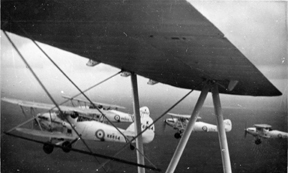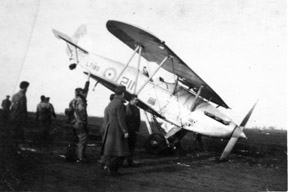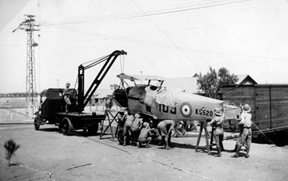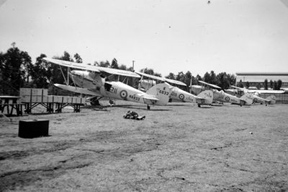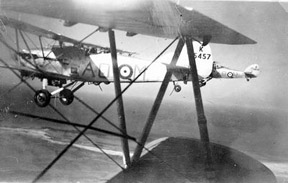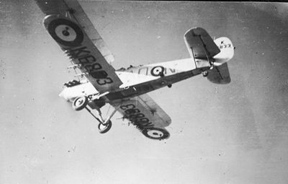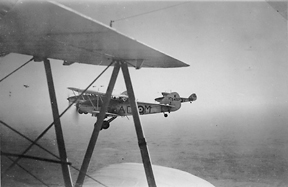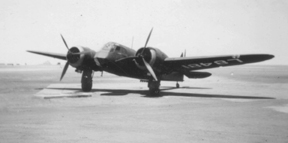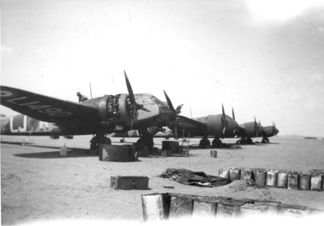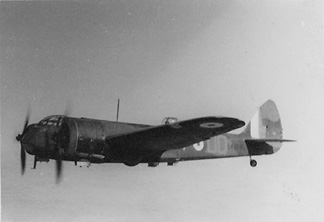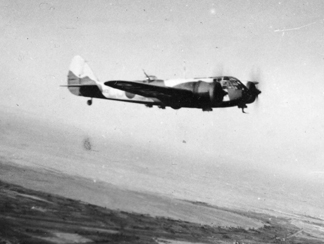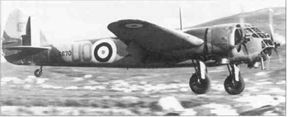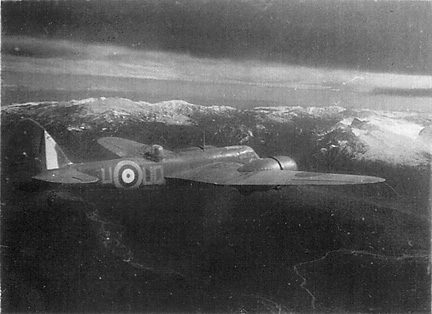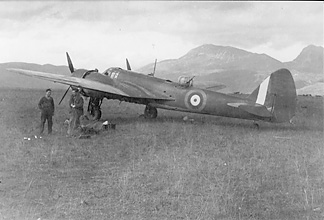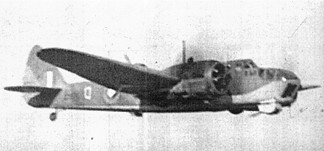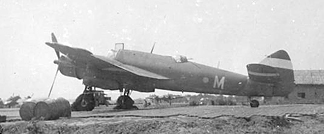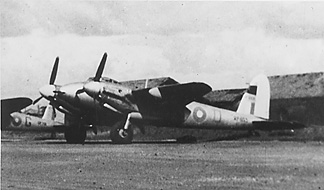 |
 |
||||||||||||||||||
|
Squadron markings and codes 211 Squadron at home Though recommended and commonly followed (but by no means uniformly applied), this potential intelligence gift ceased with the Munich crisis in September that year, with adoption of the two-letter unit codes that offered modestly better security against Order of Battle analysis. At least in the Home Commands, the Munich crisis also saw silver-doped biplanes quickly camouflaged by their units in the field.
K6854 in company with K6852, L7174 and others on a very overcast day, in silver dope with no Squadron numbers in evidence. From the collection of Geoff Grierson, thanks to son Mike Grierson. Geoff’s log and photographs of the Hind period show that 211 Squadron practice varied from aircraft to aircraft both at home and abroad.
An accident at home, exact date unknown but noted as 1938 in Geoff Grierson’s album. Again in silver dope, this time wearing the Squadron number, possibly in red. Repaired, L7180 went with 211 to the Middle East and passed (with several others) to the Royal Afghan Air Force in July 1939. Thirty years later, L7180 was one of four Hawker Hinds donated to museums by the Afghan government. Today the aircraft is kept in a fine restored state at the National Aviation Museum of Canada. To the Middle East Geoff Grierson’s shots on arrival in Egypt show the offloading of partially disassembled aircraft: K6618 without a Squadron no, and K5520 still wearing 103 Squadron’s number. Other Grierson shots of 211 Hinds at Ramleh shortly after their arrival in the Middle East show them displaying the correct Squadron number..
K5520, an ex-103 Squadron Hind, arrives (off-ship) in the Middle East at Aboukir Aircraft Depot 28 April 1938 for 211 Squadron. By September 1939 this aircraft had been returned from the Squadron to a Conversion Flight. Damaged in a forced landing near Qasaba near the end of February 1940, it was struck off charge as beyond economic repair by 1 ARS.
At Ramleh in Palestine, in July, August or September 1938, four 211 Squadron aircraft line up. The leading machine is K6833, with its rather dark (red) 211 squadron number, is probably of ‘A’ Flight. Lined up behind are L7174, K6854 and K6842. As the level of political tension rose in Europe, at the end of September the Squadron was recalled to Egypt and made ready to take up its Western Desert War Station. 211 Squadron after the Munich Crisis Here for the first time we see evidence of an earlier pre-war Squadron code, AO, on uncamouflaged 211 Squadron aircraft in the Middle East in October 1938 (shortly after Munich). To find evidence of this earlier pre-war set, presumably authorised by an issue of Secret Document SD110, was really quite startling.
211 Squadron AO-M K5457 and K6833 AO-N in formation. Very close inspection of the line-up of 9 Hinds on the ground at Daba also dated October 1938 (see Middle East) also shows the AO code in use. From the serial numbers and Geoff Grierson’s log, there is no doubt at all that these are 211 Squadron aircraft.
Hind K6833 AO-N with plenty of underside detail. Bomb-aiming hatch open, under-wing racks empty, and the new post-Munich identification letters clearly displayed.
A magnificent Middle East air to air shot. There are eight Hawker Hinds in this photograph of Geoff Grierson’s, including AO-M K5457 nearest camera and AO-N K6833, all in silver dope. In scanning the photographs from his father’s albums, Mike Grierson looked at the originals very closely for me and made the following observations: “The line up of Hinds at El Daba is dated on the back of the photo: Oct 1938, that predates the move there and does not appear to show any letters [sic - see remark above]. The airborne shot was right next to it, and appears to have been processed in the same batch, it has an identical sepia appearance, again it is dated Oct 1938 on the back, and the aircraft have letters. The shots of El Daba again appear to be from the same batch and are dated Oct 38. The shot from below K6833 is in a different Album, the picture is stuck in so I can't check the back however all other photos on the page are dated 1938 and it clearly states 211 Sqn Hind.” AO is also recorded as later used by 223 with its Wellesleys far away in The Sudan (sometimes reported as OA!). Blenheim days
While the RAAFA caption reads No 211 Squadron, RAF, Ismailia, Egypt, 1939. Bristol Blenheim, the identification is not certain. L8481 is recorded elsewhere as a 45 Squadron aircraft (though ME aircraft records are known to be rather incomplete) and does not appear in 211 Squadron sources available to me. From the photo itself, there is a faint hint that Helwan may be a more likely place: the pyramid under the starboard wing. In any event, a good example of the as-new state of Blenheim Is in the Middle East, with then-standard under-wing serials and no roundel. Image by kind permission of the Hughie Edwards Memorial Photographic Library, RAAFA Aviation Heritage Museum of Western Australia. In the Middle East, that scheme seems to have remained perhaps until Italy entered the war, after which dark earth/mid stone upper surfaces were adopted at some point, with a pale blue or azure under surface. 211 Squadron aircraft went to Greece in this scheme, where they reverted to dark earth/dark green. Mark IVs arrived in the Middle East in dark earth/dark green/sky. From September 1938, then, the more secure 2-letter Squadron codes and individual aircraft letters were to be placed either side of the fuselage roundels, though their order of placement was not specified. Commonly, although by no means universally, the codes were so placed that they read correctly whether looking at the port or the starboard side of the fuselage (as AO-M for example, worn by 211 Squadron Hawker Hind K5457). The placement of codes was far from uniform, however, and seem to have been less uniformly applied by units in overseas Commands than in Home Commands. For 211 Squadron’s Blenheim Is a different practice seems to have been adopted during the later LJ and war-time UQ periods: unit code aft of the roundel and aircraft letter forward, whether port or starboard. The display of code letters on aircraft was to become notionally mandatory in April 1939. Shortly after this date, on conversion to the Blenheim, 211 Squadron was using the code LJ.
A fine undated image of four 211 Squadron aircraft under maintenance, L1490 R-Robert leading, and L1488 next in line. Fully protected with the luxury of engine and cockpit covers, and resplendent in the pre-war code LJ (“no evidence of use” according to Lake): here in white with careful grey 3D edging, a not uncommon flourish of the late inter-war period. Given code and colour, perhaps around April (on Squadron conversion) to perhaps September 1939. The other markings are slightly unusual: the large under-wing serials are accompanied by a three-colour (Type A) roundel, while the fuselage carries the two-colour Type B roundel. Shot on orthochrome film, from the tone of the red central disk. The aircraft are plainly wearing European camouflage, the black undersurfaces displaying the then usual white serial numbers and the red white and blue roundel. Following the declaration of war in September 1939, 2-letter unit codes were issued afresh, again for basic security. 211 Squadron was then allotted the letters UQ.
A fine 211 Squadron Mark I air to air shot somewhere over Egypt. The serial number, in the L4xxx series, cannot quite be made out. The grey UQ code gives a date sometime after September 1939. The aircraft apparently wears an individual letter, almost completely obscured, possibly Y-Yoke. Apparently in European paint, Type A roundels, no under-wing serials and the full fin-flash.
Another great Grierson shot. A hint at a date before June 1940, when war finally came to the Western Desert: this is one of the few shots of a 211 Squadron Blenheim with turret retracted while in flight. In GGs Log Book, Blenheim duties first appear in June 1939 at Ismailia, and he flew in L1483 on 6 July 1939. The serial number may be L1483. The squadron UQ code letters are barely discernible. Panchromatic and orthochromatic film were both in use at this period. When combined with coloured filters on cameras, the interpretation of colours becomes quite difficult. The colour scheme shown here may be in desert paint, although or it might be pre-war camouflage in the “reverse” pattern intended for even-numbered aircraft. Undersurfaces in night black with white serial numbers and old style large roundel, with the War Emergency Type B fuselage roundel, are of the camouflage standard in use from late 1938 to September 1939.
One of the best known pictures of a 211 Squadron aircraft, landing at Menidi in Greece in late 1940, here in desert paint (Middle Stone, Dark Earth and light blue undersurfaces (apparently lighter in tone than the Azure Blue later used on Mark IV aircraft in theatre), code in grey. The aircraft served with 211 Squadron on operations in the Desert from October 1940. In Greece it was flown often by the CO from early December 1940. There are many photographic examples of the UQ code in more-or-less standard form, with codes in grey, either in the same style (UQ-S L8664) or in much broader characters and either probably or certainly in grey (for example, L1487 UQ-B, L1491 UQ-S, L1540 UQ-P, UQ-U, L8376 UQ-D).
U-Uncle over Northern Greece, early 1941. Original large fin flash and roundel, and apparently European pattern camouflage. Codes in grey. However, as elsewhere, ME Cmd units did not always apply the Squadron 2-letter/Aircraft 1-letter set to the promulgated standard. 211 seems to have applied either, both or neither, as the press of events dictated.
This Mark I is in European paint on the upper surfaces, possibly sky blue beneath, without Squadron markings and with serial no obscured. The aircraft’s bomb-bay doors appear to have been removed. The scene is certainly on the ground at Paramythia, looking to the North. The relevant Air Ministry Orders from April 1939 to July 1941 explicitly note that aircraft letters are to be in grey (AMO A154/39, 27 April eg). From 1942 to 1943, references to letters in "the appropriate colour" mean dull red from May 1942 onwards—according to AMO A.664/42 of 2 July. The 211 squadron letters on Blenheim Is on operations in the Western Desert and Greece from June 1940 to April 1941 have been interpreted as dull red by many illustrators but at this date, given the Air Ministry Orders of the day and the various other examples in photographs, it is hard to conclude anything other than that they are dull grey—when present. The Far East
On operations over Burma from India after January 1944, the Beaufighters, too, seem to have carried only individual letters, apparently in white, also aft of the roundel.
There are several other independent photographs of 211 Squadron aircraft in this scheme, eg W-William, NV384 M-Mike, and those of the AWM Photographic database. The Squadron’s silver-doped Mosquito FBVI aircraft of Far East period from May 1945 also wore only individual letters aft of the two-tone blue roundel, apparently in dull blue.
Photographs of this period are rather more plentiful, and show that there was some variation in application of other SEAC markings, like the upper fin flash, absent from RF751 although also at Yelahanka about July 1945. Summary From photographic evidence it is clear that, other accounts notwithstanding, from 1938 to 1941 in the Middle East the Squadron initially used its number, then successively three sets of Squadron 2-letter codes: AO in grey on Hawker Hinds, post-Munich Of the Far East period, the examples to hand of Squadron Blenheims in 1942 and for Beaufighters from late 1943 to mid 1945 show only individual aircraft letters, apparently in white, placed aft of the roundel. From July 1945 onwards, Mosquitoes on Squadron charge also appear only with individual letters, apparently in dull blue, again aft of the roundel. Although some references give an incomplete or incorrect record of the Squadron’s use of unit codes, in Combat Codes, Flintham and Thomas have pretty well set the record straight, giving good account of RAF and Commonwealth use of unit markings and of the state of surviving records. Sources Bowyer Bombing Colours—RAF Bombers, Their Markings and Operations 1937—1973
www.211squadron.org © D Clark & others 1998—2025 |
||||||||||||||||||
